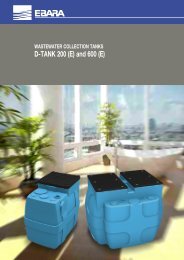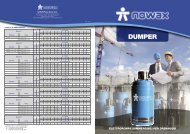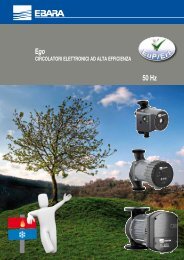i gruppi di pressurizzazione gp gp pressure booster sets groupes de ...
i gruppi di pressurizzazione gp gp pressure booster sets groupes de ...
i gruppi di pressurizzazione gp gp pressure booster sets groupes de ...
You also want an ePaper? Increase the reach of your titles
YUMPU automatically turns print PDFs into web optimized ePapers that Google loves.
electric panel by means of suitably calibrated <strong>pressure</strong><br />
switches. Drawing water from the connected system, when<br />
the pumps are stopped, causes lowering of the <strong>pressure</strong><br />
and the consequent making of the contact of the <strong>pressure</strong><br />
switch with the highest calibration value which causes<br />
starting of the first pump (or pilot pump for 2+1GP or<br />
3+1GP <strong>sets</strong>). If the <strong>pressure</strong> drop continues or restoring is<br />
not sufficient, the second <strong>pressure</strong> switch intervenes and so<br />
the second pump starts, and so on if the set is provi<strong>de</strong>d<br />
with a third and fourth pump (main pumps). The restoring<br />
of the <strong>pressure</strong> in the system causes the making of the<br />
<strong>pressure</strong> switch contacts and the staggered stopping of the<br />
pumps. An electronic <strong>de</strong>vice activates the automatic<br />
rotation of the starting or<strong>de</strong>r of the electropumps so as to<br />
ensure uniform <strong>di</strong>stribution of the starting operations, and<br />
therefore of the working hours.<br />
4.1 STANDARDS AND REGULATIONS<br />
The <strong>pressure</strong> <strong>booster</strong> <strong>sets</strong> have been <strong>de</strong>signed and ma<strong>de</strong> in<br />
compliance with the following regulations and standards:<br />
• Machines Directive 98/37/EEC<br />
• Low Voltage Directive 73/23/EEC<br />
• Directive on Electromagnetic Compatibility 89/336/EEC<br />
and subsequent updates<br />
• European Standards: EN60204-1; EN60439-1;<br />
EN60335-2-41; EN500081; EN50082; EN809; EN292<br />
4.2 CONSTRUCTION CHARACTERISTICS<br />
The <strong>pressure</strong> <strong>booster</strong> <strong>sets</strong> are supplied complete with:<br />
-electropumps – <strong>pressure</strong> gauge – <strong>pressure</strong> switches –<br />
manifold on suction and on <strong>de</strong>livery – isolating valves on<br />
suction and on <strong>de</strong>livery – check valve on suction - nipples<br />
on suction with G 1/2 UNI ISO 228 coupling for<br />
connection to an air fee<strong>de</strong>r – various couplings – electric<br />
control panel – single base – vibration-damping supports.<br />
Vertical <strong>di</strong>aphragm type vessels on <strong>de</strong>livery are supplied<br />
on request and separately.<br />
Pressure switch kit for minimum <strong>pressure</strong> on request.<br />
4.3 COMPONENTS<br />
• Depen<strong>di</strong>ng on type, the electropumps may be singleimpeller,<br />
twin-impeller, multistage with horizontal or<br />
vertical axis. Bo<strong>di</strong>es of cast iron or stainless steel Aisi<br />
304, impellers in technopolymer, cast brass, cast iron,<br />
Aisi 304. Mechanical seal in carbon/ceramic/NBR.<br />
Standard asynchronous electric motors, <strong>de</strong>gree of<br />
protection IP44÷IP55 class F.<br />
• Manifolds: galvanised steel, accor<strong>di</strong>ng to UNI 8863,<br />
threads UNI ISO 228/1, flanges to UNI standards with<br />
rated <strong>pressure</strong> PN10-PN16.<br />
• Nickel-plated brass interception ball valves<br />
PN10/PN16, seal in PTFE; butterfly valves in painted<br />
cast iron, seal in EPDM.<br />
• Check valves PN10/PN16 spring or flap type, brass<br />
body, NBR rubber seal.<br />
• Couplings PN 25 galvanised cast iron and brass, threads<br />
UNI ISO 7/1.<br />
• Bourdon spring <strong>pressure</strong> gauges, plastic casing, brass<br />
coupling, scale in bar and in psi.<br />
• Adjustable <strong>pressure</strong> switches with <strong>di</strong>aphragm in NBR,<br />
bipolar, silver contacts, plastic casing, protection IP54.<br />
• Base, electric panel supports: galvanised steel.<br />
• Electric panel: plastic or metal casing, protection IP55.<br />
• Nuts and bolts: galvanised steel.<br />
• Components in stainless steel on request.<br />
10 – GP<br />
5. TESTING<br />
Before packing, 100% of <strong>pressure</strong> <strong>booster</strong> <strong>sets</strong> are<br />
subjected to routine hydraulic, mechanical and electric<br />
tests as <strong>de</strong>scribed in points 5.2 and 5.3.<br />
5.1 CALIBRATING THE PRESSURE SWITCHES<br />
The <strong>pressure</strong> switches are calibrated (at ambient<br />
temperature) accor<strong>di</strong>ng to the following standard table:<br />
P0 = max <strong>pressure</strong> of pump n°1 (or pilot pump) with<br />
aperture closed<br />
P1 ÷ P8 = calibrating <strong>pressure</strong>s in bar<br />
∆P = minimum <strong>di</strong>fferential in bar<br />
NB: <strong>de</strong>pen<strong>di</strong>ng on the characteristics of certain types of<br />
pumps (with flat curve), the <strong>pressure</strong> switch for pump n°1<br />
(or pilot) may be calibrated at a stopping <strong>pressure</strong> P1= P0<br />
– 0.3 bar<br />
Any <strong>di</strong>aphragm tanks must be calibrated by the user at a<br />
<strong>pressure</strong> 0.3÷0.5 bar lower than the starting <strong>pressure</strong> of the<br />
<strong>pressure</strong> switch of the last pump (minimum <strong>pressure</strong>).<br />
Regulating range:<br />
Regulating procedure:<br />
1. Completely slacken the nut or the regulating screw “B”<br />
of <strong>pressure</strong> switch 1 of pump n°1 (in this way you have<br />
the minimum <strong>di</strong>fferential ∆P)<br />
2. Start pump n°1 by means of the manual control (or the<br />
pilot pump when the set is provi<strong>de</strong>d with one).<br />
3. Slowly close the isolating valve downstream from the set<br />
until the <strong>de</strong>sired stop <strong>pressure</strong> (rea<strong>di</strong>ng on the <strong>pressure</strong><br />
gauge), regulate <strong>pressure</strong> switch n°1 by rotating the nut<br />
or the screw “A” until the contact clicks open, this<br />
operation will stop the pump.<br />
4. Slowly open the isolating valve downstream from the<br />
set, which causes a loss of <strong>pressure</strong> of the system until<br />
the contact clicks shut on <strong>pressure</strong> switch n°1(which is<br />
already set with minimum ∆P), this operation will start<br />
the pump. Check regulation by increasing and<br />
<strong>de</strong>creasing the <strong>pressure</strong> downstream from the system,<br />
always using the isolating valve.<br />
5. Perform the same operations for the set’s remaining<br />
<strong>pressure</strong> switches.<br />
6. Discharge the <strong>pressure</strong> downstream, set automatic<br />
operation on the control panel, slowly open the<br />
isolating valve downstream from the set, check the<br />
casca<strong>de</strong> intervention calibrations of the pumps at least





